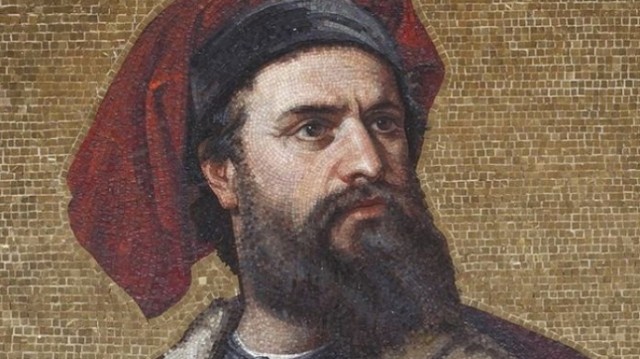Polo, Marco (1254–1324)
MARCO POLO IS THE best known of all Western travelers along the SILK ROAD. He traveled Asia for 24 years, all the way to CHINA, where he became confidant of Kublai Khan (1214–94.) He also wrote of his travels. Marco was born in ITALY, either in Curzola off the Dalmatian coast or in Venice, in 1254. He grew up in Venice, the center of Mediterranean commerce. As befitted the son of nobility, he was educated as a gentleman.
When Marco was six, his father and uncle, merchants of Venice, traveled to Sudak on the Crimea, then to Surai on the Volga River. When civil war broke out, the brothers Polo went to BOKKARA, where they remained for three years. While there, they encountered an ambassador from the Mongol Hulagu Khan. With him they traveled to BEIJING, arriving in 1266. After a year, the brothers returned to Italy with a letter from the Great Khan to Pope Clement IV asking for 100 learned men to teach the Mongols of China about Western ways and religion. Marco accompanied his father and uncle on the next trip to China. Marco was 17. Bearing gifts and letters from Pope Gregory X, the Polos traveled through ARMENIA, Persia, and AFGHANISTAN, over the Pamirs, and all along the Silk Road to China. At Badakhshan, Marco became ill, forcing a year's delay. Once over the Pamirs, the highest place in the world, they crossed the Taklamakan desert. Polo recorded the interesting sights and people. His descriptions were clear and able to generate some sense of the feelings the natural and human wonders he encountered. He noted that although dangerous, the route was well traveled. He also produced a detailed history of the Mongols and the Great Khan. He described life on the STEPPEs. He talked of marriage customs and life in general. After the Polos arrived in Shang-tu, the summer capital, Polo began to chronicle China under the Mongol ruler.

As a member of the court and fluent in four languages, Marco Polo traveled to China, Burma, and INDIA, places not seen again by Westerners until the 19th century. He described ceremonies, hunting, and the new capital city. Much of this could be translated into terms easily understood in the West because comparable activities occurred there.
Some things were totally new to him: asbestos, fireproof cloth, paper currency, coal, the imperial post, crocodiles, coconuts. Polo's travels showed him great power and wealth and an extremely complex society. China's economy far surpassed that of all Europe. China generated 125,000 tons of iron a year, an output not matched until the 18th century in Europe. A canal network linked large cities in a commercial network. Credit was available, as was paper money. The Khan's message system was so efficient that a high-priority message could travel in one day the same distance a lone traveler would cover in 10 days. The level of prosperity was well beyond the wildest European imaginings. Polo even joined the Privy Council in China in 1277. He served as tax inspector in Yanzhou, on the Grand Canal northeast of Nanking.
For 17 years, the Polos remained at the Chinese court. They amassed great stores of gold and jewels. They wanted to be sure they could get their fortunes out of the country before Kublai Khan, then in his late 70s, died. Reluctantly the Khan agreed, and the Polos took two years to get home by sea. In Persia, they learned of the death of Kublai Khan, but his golden tablet of authority still protected its possessors, and they were able to travel through dangerous territory safely. They arrived in Venice in 1295.
In 1298, Polo commanded a galley in the Venetian war against Genoa. Captured, he spent a year in prison. There he met a romance writer, Rustichello of Pisa. Rustichello convinced Marco to dictate The Description of the World or The Travels of Marco Polo. Polo's descriptions of China, India, and Africa made his writings one of the most popular books of medieval Europe. Unfortunately, most Europeans referred to it as Il Milione, or The Million Lies.
With peace in 1299, Polo returned to Venice. He married and had three daughters and remained in Venice until his death at age 70. His deathbed statement was, “I have only told the half of what I saw!” Subsequent scholars wondered about Polo's truthfulness. He didn't mention the Great Wall, nor did he learn Chinese. He ignored common things such as foot binding, calligraphy, and tea. He never became an entry in the Chinese Annals of the Empire, wherein all important visitors were recorded. These discrepancies raise the question of whether or not the Polos actually went to China.
Polo's book retained a strong readership, with hundreds of manuscript editions in the century after his death. It was the most important travelogue of its time, and the most important on the Silk Road ever written in a European language. Eighty manuscript copies of his books in various versions remain extant. Scholars continue to examine and authenticate the travels of Polo. Geographers in the 14th century began using his maps in publications such as the Catalan World Map of 1375, used by Christopher Columbus and Prince Henry the Navigator. His distances were accurate, and he was perhaps the precursor of a scientific geographer. Much was validated by 18th- and 19th-century travelers. Even Chinese historians use his work to better understand the events of their 13th century.